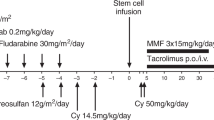Abstract
We investigated the feasibility and efficacy of a fludarabine-based dose-reduced conditioning regimen followed by stem cell transplantation from related (n = 5) or unrelated HLA-matched donors (n = 7) in 12 patients with high risk MDS, who were not eligible for a standard myeloablative conditioning regimen. The conditioning regimen consisted of fludarabine 30 mg/m2 daily for 6 days, busulfan 4 mg/kg daily for 2 days and anti-thymocyte globulin (ATG, rabbit) 10 mg/kg daily for 4 days in 11 patients, while one patient received fludarabine, ATG, cyclophosphamide and thiotepa. Graft-versus-host disease prophylaxis consisted of cyclosporine and a short course of methotrexate. The median age of the patients was 53 years (range 37–59). The median percentage of blasts in bone marrow aspirate at transplantation was 15% (range <5% to 35%). Diagnosis at transplant was RA (n = 1), RAEB (n = 5), RAEB-T (n = 5) and sAML (n = 1). A complex karyotype including monosomy 7 was noted in five patients. The reasons for using a dose-reduced conditioning regimen were prior autologous/syngeneic BMT (n = 4), active fungal infection (n = 2) or age/reduced performance status (n = 6). Engraftment was observed in all patients with complete donor chimerism. The incidence of acute GVHD (grade II–IV) was 33%. Eight patients died during follow-up due to relapse (n = 4), liver toxicity (n = 2), aspergillus (n = 1) or aGVHD grade IV (n = 1). After a median follow-up of 19 months, the 2-year estimated disease-free survival is 12% (95% CI: 2–23%) and the overall survival is 26% (95% CI: 4–52%). Fludarabine dose-reduced conditioning prior to allogeneic stem cell transplantation in high risk MDS patients, who were not eligible for standard transplantation, resulted in stable engraftment with complete chimerism, but the toxicity and relapse rate were considerable. Bone Marrow Transplantation (2001) 28, 643–647.
This is a preview of subscription content, access via your institution
Access options
Subscribe to this journal
Receive 12 print issues and online access
$259.00 per year
only $21.58 per issue
Buy this article
- Purchase on Springer Link
- Instant access to full article PDF
Prices may be subject to local taxes which are calculated during checkout


Similar content being viewed by others
References
Bennett JM, Catovsky D, Daniel MD et al. Proposals for the classification of myelodysplastic syndromes Br J Haematol 1982 51: 189–199
Geddes A, Bowen D, Jacobs A . Clonal karyotypic abnormalities and clinical progress in the myelodysplastic syndromes Br J Haematol 1990 76: 194–202
De Witte T, Hermans J, Vossen J et al. Haematopoietic stem cell transplantation for patients with myelodysplastic syndromes and secondary acute myeloid leukemias: a report on behalf the Chronic Leukemia Working Party of the European Group for Blood and Marrow Transplantation (EBMT) Br J Haematol 2000 110: 620–630
Slavin S, Nagler A, Naperstek E et al. Nonmyeloablative stem cell transplantation and cell therapy as an alternative to conventional bone marrow transplantation with lethal cytoreduction for the treatment of malignant and nonmalignant diseases Blood 1998 91: 756–763
Giralt S, Estey E, Albitar M et al. Engraftment of allogeneic hematopoietic progenitor cells with purin analog-containing chemotherapy: harnessing graft-versus-leukemia effect without myeloablative therapy Blood 1997 89: 4531–4536
McSweeney P, Storb R . Establishing mixed chimerism with immunosuppressive, minimally myelosuppressive conditioning: preclinical and clinical studies American Society of Hematology Educational Book 1999 pp 396–405
Child R, Clave E, Contentin N . Engraftment kinetics after nonmyeloablative allogeneic peripheral blood stem cell transplantation: full donor T-cell chimerism precedes alloimmune responses Blood 1999 94: 3234–3241
Przepiorka KM, Weisdorf D, Martin P . 1994 Consensus Conference on acute GVHD-grading Bone Marrow Transplant 1995 15: 825–828
Bearman SI, Appelbaum FR, Buckner CD . Regimen-related toxicity in patients undergoing bone marrow transplantation J Clin Oncol 1988 6: 1562–1568
Kaplan EL, Meier P . Nonparametric estimation from incomplete observations J Am Stat Ass 1958 53: 457–460
Rezvani K, Lalancette, Szydlo R et al. Non-myeloablative stem cell transplant in AML, ALL, and MDS: disappointing outcome for patients with advanced phase disease Blood 2000 96: (Suppl.) 2061
Shing MMK, Vowels M . Role of second bone marrow transplants Bone Marrow Transplant 1993 12: 21–24
Barrett AJ, Locatelli F, Treleaven JG et al. Second transplants for leukaemic relapse after bone marrow transplantation: high early mortality but favourable effect of chronic GvHD on continued remission Br J Haematol 1991 79: 567–571
Nagler A, Or R, Naparstek E et al. Second allogeneic stem cell transplantation using nonmyeloablative conditioning for patients who relapsed or developed secondary malignancies following autologous transplantation Exp Hematol 2000 28: 1096–1104
Acknowledgements
We thank the staff of the BMT unit for providing excellent care of our patients and the medical technicians for their excellent work in the BMT laboratory.
Author information
Authors and Affiliations
Rights and permissions
About this article
Cite this article
Kröger, N., Schetelig, J., Zabelina, T. et al. A fludarabine-based dose-reduced conditioning regimen followed by allogeneic stem cell transplantation from related or unrelated donors in patients with myelodysplastic syndrome. Bone Marrow Transplant 28, 643–647 (2001). https://doi.org/10.1038/sj.bmt.1703215
Received:
Accepted:
Published:
Issue Date:
DOI: https://doi.org/10.1038/sj.bmt.1703215
Keywords
This article is cited by
-
Reduced-intensity stem cell transplantation for acute myeloid leukemia with fludarabine-based conditioning with intravenous busulfan versus melphalan
Bone Marrow Transplantation (2020)
-
Optimizing drug therapy in pediatric SCT: Focus on pharmacokinetics
Bone Marrow Transplantation (2015)
-
Treosulfan-based conditioning before hematopoietic SCT: more than a BU look-alike
Bone Marrow Transplantation (2012)
-
Intermediate intensity conditioning regimen containing FLAMSA, treosulfan, cyclophosphamide, and ATG for allogeneic stem cell transplantation in elderly patients with relapsed or high-risk acute myeloid leukemia
Annals of Hematology (2012)
-
5-Azacitidine for myelodysplasia before allogeneic hematopoietic cell transplantation
Bone Marrow Transplantation (2010)



